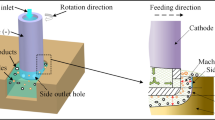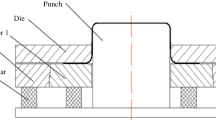Abstract
In computer numerical control (CNC) grinding of free-form surface, an ideal arc profile of trued diamond grinding wheel is generally employed to plan 3D tool paths, whereas its form-truing errors greatly influence the ground form accuracy. A form-truing error compensation approach is proposed by using an approached wheel arc profile to replace the previously designed ideal one. The objective is to directly compensate the trued wheel arc-profile errors. It may avoid the time consumption of traditional approach that compensates the measured coordinate point errors of workpiece to an iterative grinding operation. First, the 3D tool path surface was constructed to plan the 3D tool paths. Second, the CNC arc truing of grinding wheel was conducted to analyze the form-truing error distribution relative to the applied wheel arc profile. Then, the form-truing error compensation was carried out in CNC envelope grinding. Finally, the iterative closest point (ICP) algorithm was used to match the measured coordinate points of workpiece to ideal free-form surface. It is shown that the 3D tool path surface constructed is practicable to plan arbitrary 3D tool paths for the form-truing error compensation. The ICP matching may be used to investigate 3D ground form error distribution. It is confirmed that the form-truing error compensation can directly improve the 3D ground form accuracy. It may decrease the 3D ground form error by about 20% when the 2D form-truing error is reduced by about 58% using the same truing conditions for CNC grinding.
Similar content being viewed by others
References
Suzuki H, Nino Y, Murakami S, Namba Y (1994) Development of ultra-precision grinding machine for grazing incidence X-ray mirrors. J Jpn Soc Precis Eng 60:1309–1313
Sazedur Rahman M, Saleh T, Lim HS, Son SM, Rahman M (2008) Development of an on-machine profile measurement system in ELID grinding for machining aspheric surface with software compensation. Int J Mach Tools Manuf 48:887–895. doi:10.1016/j.ijmachtools.2007.11.005
Kuriyagawa T, Zahmaty MSS, Syoji K (1996) A new grinding method for aspheric ceramic mirrors. J Mater Process Technol 62:387–392
Stephenson DJ, Sun X, Zervos C (2005) A study on ELID ultra precision grinding of optical glass with acoustic emission. Int J Mach Tools Manuf 46:1053–1063. doi:10.1016/j.ijmachtools.2005.08.013
Okuyama S, Iwaya T, Kitajima T, Suzuki H, Stsunobu A (1998) Study on the round-off truing using the circular motion of CNC grinding machine. J Jpn Soc Precis Eng 64:1669–1673
Xie J, Dang XM (2008) Experiment on CNC arc truing of diamond grinding wheel by mutual wear. Chin J Mech Eng 44:102–107
Xie J, Tamaki J (2008) Computer simulation of sub-micron-scale precision truing of a metal-bonded diamond grinding wheel. Int J Mach Tools Manuf 48:1111–1119. doi:10.1016/j.ijmachtools.2008.02.004
Lopez de Lacalle LNL, Lamikiz A, Sanchez JA, Salgado MA (2007) Toolpath selection based on the minimum deflection cutting forces in the programming of complex surfaces milling. Int J Mach Tools Manuf 47:388–400. doi:10.1016/j.ijmachtools.2006.03.010
Kim SJ, Yang MY (2006) A CL surface deformation approach for constant scallop height tool path generation from triangular mesh. Int J Adv Manuf Technol 28:314–320. doi:10.1007/s00170-004-2372-4
Feng X, Hongzan B (2003) CNC rake grinding for a taper ball-end mill with a torus-shaped grinding wheel. Int J Adv Manuf Technol 21:549–555
Hsieh JM, Tsai YC (2006) Geometric modeling and grinder design for toroid-cone shaped cutters. Int J Adv Manuf Technol 29:912–921. doi:10.1007/s00170-005-2613-1
Huang H, Chen WK, Kuriyagawa T (2007) Profile error compensation approaches for parallel nanogrinding of aspherical mould inserts. Int J Mach Tools Manuf 47:2237–2245. doi:10.1016/j.ijmachtools.2007.06.008
Zhang YH, Wang LH, Ma CX, Wu Q, Hu DJ (2008) A new digital measurement method for accurate curve grinding process. Int J Adv Manuf Technol 36:305–314. doi:10.1007/s00170-006-0844-4
Xie J, Xu WW (2006) Arc envelope grinding of non-axisymmetric aspheric surface using equal-envelope height. Mater Sci Forum 532(533):189–192
Xie J, Xu WW, Tamaki J (2007) 3D simulation of arc envelope grinding of non-axisymmetric aspheric surface. Int J Machining and Machinability of Materials 2:85–96. doi:10.1504/IJMMM.2007.012669
Author information
Authors and Affiliations
Corresponding author
Rights and permissions
About this article
Cite this article
Xie, J., Zhou, R.M., Xu, J. et al. Form-truing error compensation of diamond grinding wheel in CNC envelope grinding of free-form surface. Int J Adv Manuf Technol 48, 905–912 (2010). https://doi.org/10.1007/s00170-009-2338-7
Received:
Accepted:
Published:
Issue Date:
DOI: https://doi.org/10.1007/s00170-009-2338-7




